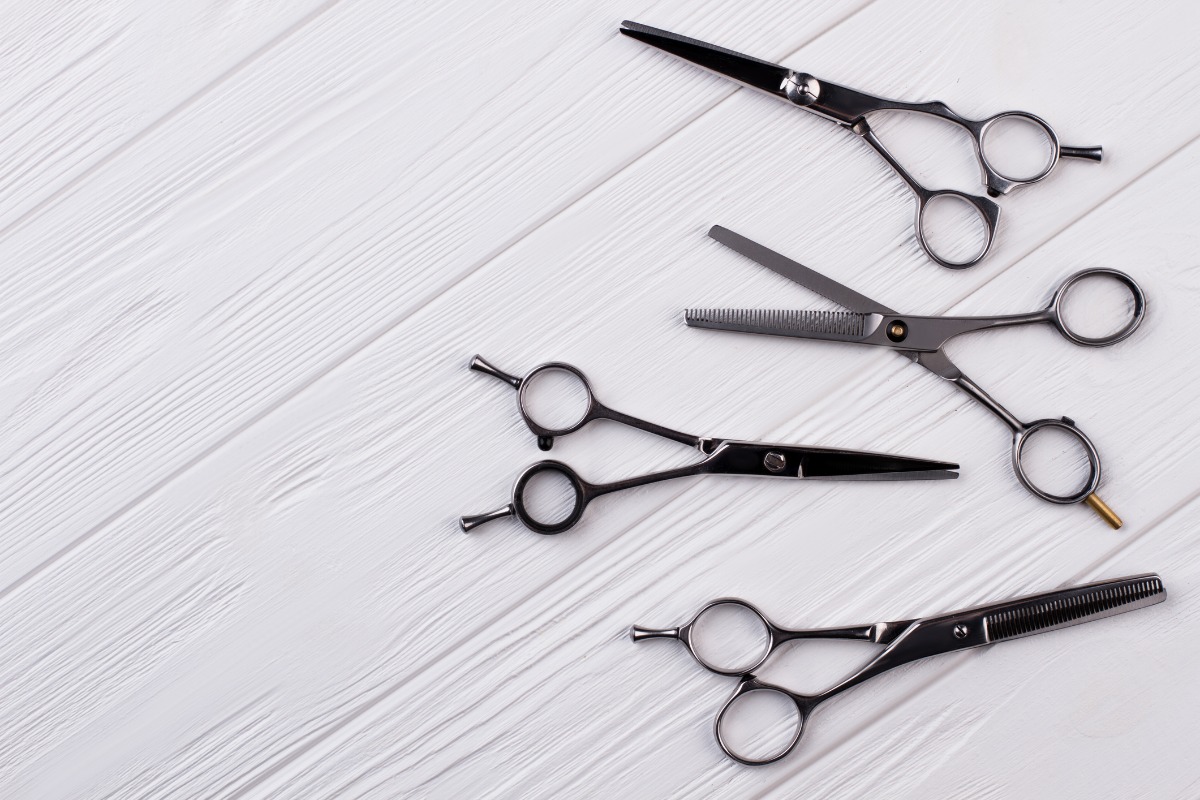There are various types of hair scissors edges and blades. They include the sword blade, K-blade, convex blade, bevelled blade, concave blade, and serrated blade.
The curved blade is more suited for soft cuts with its sharp blade. The single or flat blade is best suited for hair with lightweight toughness. Here is a detailed explanation of the various scissors edge types.
The Sword Shape Scissor Blade

As the name suggests, the sword shape scissor blade is shaped like a sword. It is designed to concentrate power at the point of the blade. This scissors has a convex edge and a sword blade or clam shell.
The sword blade design outputs more power to the blade for detailed, top-notch hair cutting.
The sword scissors come with a ridge running down the length of the blade. This helps it to attain strong cuts regardless of the shear’s length. This is a stark difference to other blades, whereby the shear’s length affects the blade’s power. The sword blade works just as advertised.
The Standard, Flat, Single Bevel Scissors Blade
The flat bevel blade is the most popular type of blade in the world. It is the first and original scissors blade. It is also one of the least expensive scissors blades that you can find around.
It comes with a light body to support its flat blade.
Also known as the standard blade, the flat blade works fine for a smooth cut. Even though other blades have been invented after it, this blade remains relevant till today. It is an efficient, organized cutter that works as advertised.
A major drawback of the flat blade is that it can’t be used for complicated cutting styles. Also, it requires the application of more pressure and force than what you need for other blades.
The Concave Scissor Blade
The concave scissor blade is designed for optimal cutting. It’s cutting load is lower than that of other scissors. This helps it to cut hair easily and efficiently.
Serrated and Micro-serrated Blade
The serrated and micro-serrated blade are often used together with the bevelled edge blade. The micro-serrated blade is best for novices because its design stops hair from sliding downwards the blade.
Learners can learn with the serrated edge scissors, but it holds the hair like a comb, and it could damage the cuticles when it cuts through the hair.
These blades are recommended for slow, detailed cutting and dry hair. On the flip side, you can’t use them for slice cutting because hair often gets stuck on the blades. This blade is also typically used for scissor and not comb cutting.
The blade edges get hair stuck on it and disturb pushing, which is why we recommend it for dry hair cutting and wigs.
The Convex Scissor Blades
The convex scissor blades are of two types. They include the convex shape blade and the convex pro blade.
The Convex Shape Blade
The convex shape blade is an improvement over the previous convex blade. It is a sharp, soft blade that can be used for any cutting technique.
This makes it usable by both professionals and amateurs. Even though it has a wide range of uses, this blade is best used for point cutting and texturizing.
The convex shape blade has sharp edges that rub one another on the edge’s hollow side. To stop the edges from rubbing each other, they have a hone line that is ground in hollow along the blade edges.
The hone line is a thin line from the scissor’s tip down to the back. This line can be seen on the hollow side of the scissor’s edge.
The Convex Pro Blade
The convex pro blade comes with the sharpest blade setting and angle. It is the blade to get for those that want a smooth, sharp cut. The blade’s manual finishing has been worked on manually by a craftsman for the most intricate, artistic cut.
The cross-section of the blade is powerful and large. The blade’s point is much miniature than a hair, so that hairs won’t fly about. The design of this blade makes for sharp, smooth cuts.
It works fine for slide cutting and other complex hair cutting techniques because of the curved outer blade face.
The convex pro blade’s cutting edges has a sharp angle that helps for sharp looks and smooth cuts. This blade is steeply expensive and more difficult to produce due to its intricacies.
Scissor Blade Lines
Scissor blade lines range from the straight ones to the curved ones. The name for each blade is dependent on where the blade falls within the range.
The straight blade, as it implies is for blades that are straight. Willow blades are ordinary blades. Lastly, the bamboo leaf blade is a curved blade.
The unique characteristics of each item are considered for their designs. Straighter blades are easier to hold hair for cutting without sliding.
The larger the hair curve is, the larger the amount of hair that will slide across the blade when opting for soft and smooth cutting. The curvier bamboo leaf blade is often used for slicing and slide cuts.
Scissor Blade Width
Various scissor widths are available. The width determines how powerful a blade is for cutting hair. The wider the blade, the more the power. For detailed cutting jobs, thin, light blades are preferred.
The blade line radius shape and the metal hardness, and the cutting edge are the major determining factors for deciding how a blade cuts and the cutting that it is used for.
Long, slim scissors with narrow blades are best for heavy point cutting and blunt work. These blades typically have a line radius of about 90cm to 100cm and an edge angle that is between 50⁰ to 55⁰.
